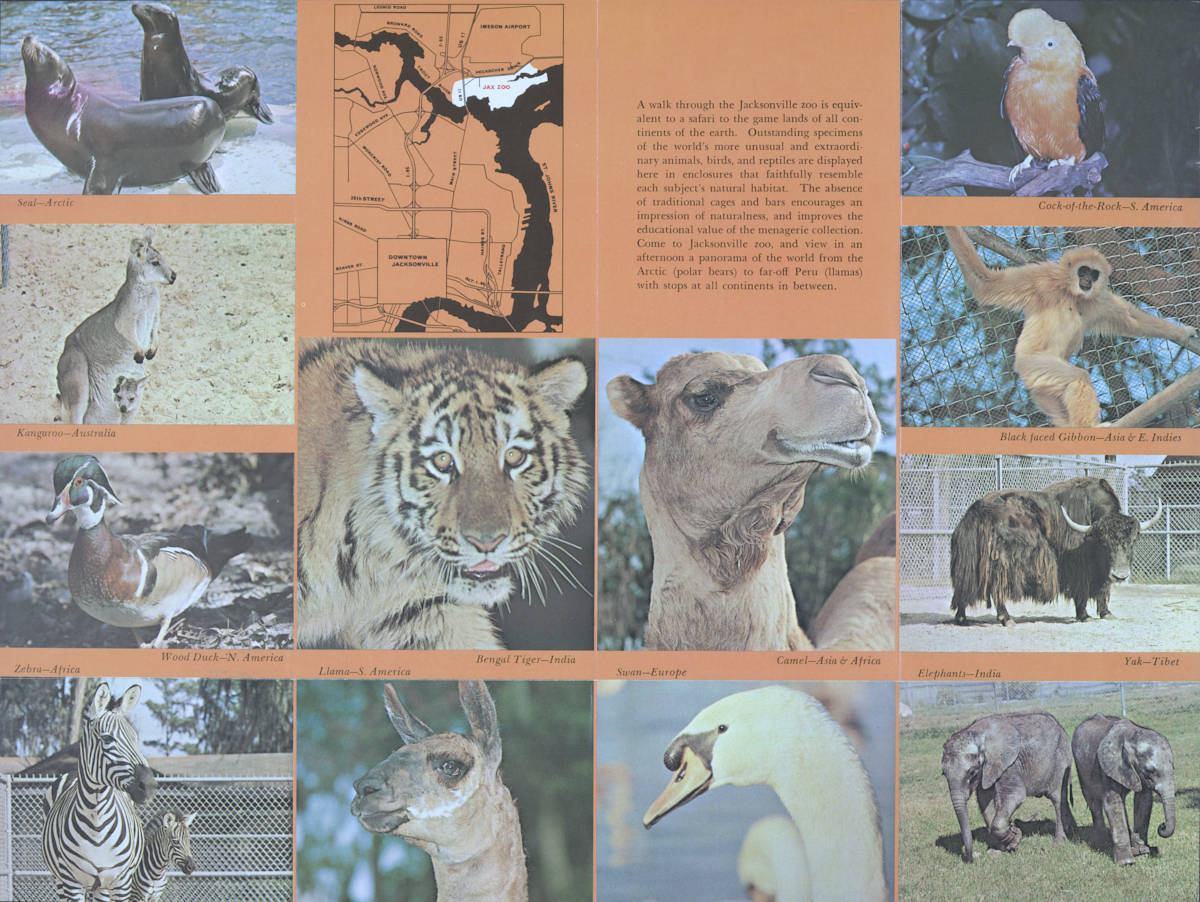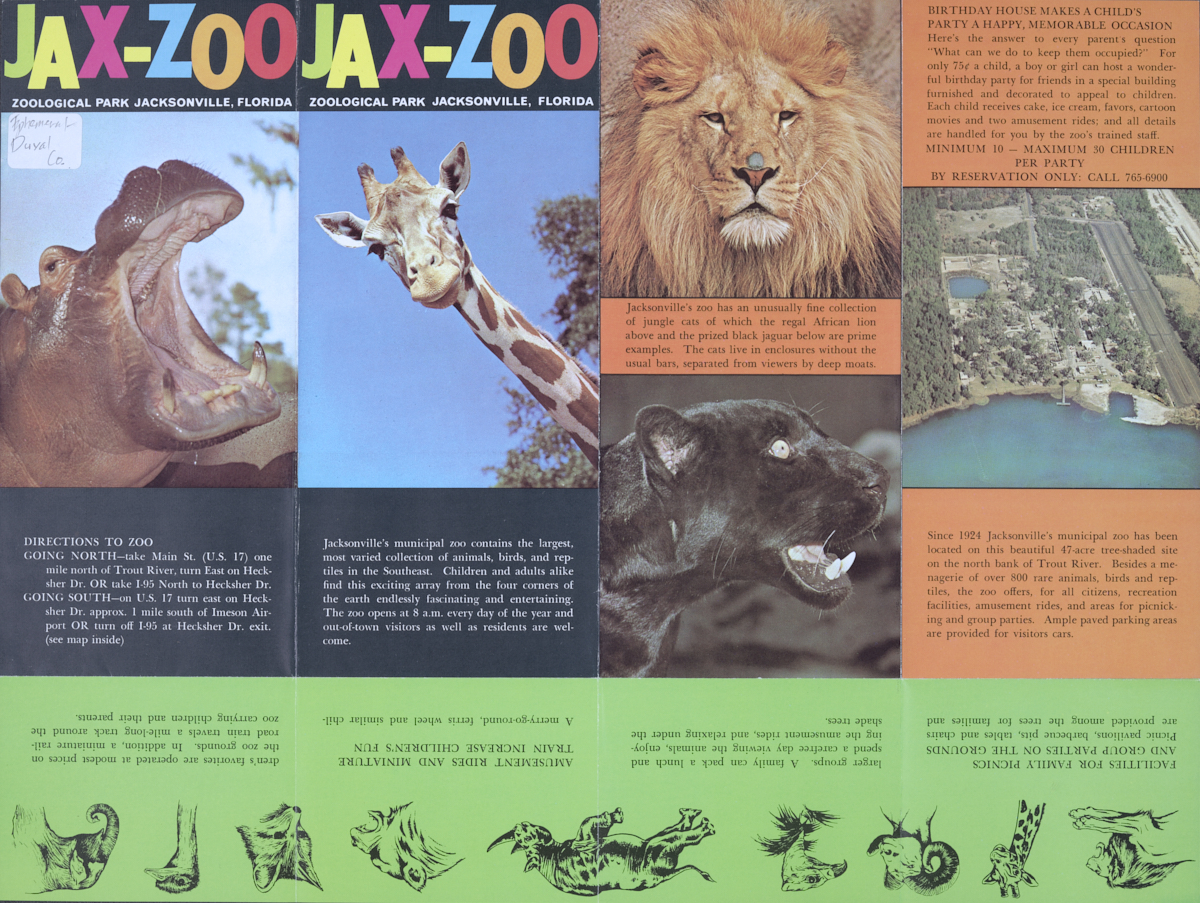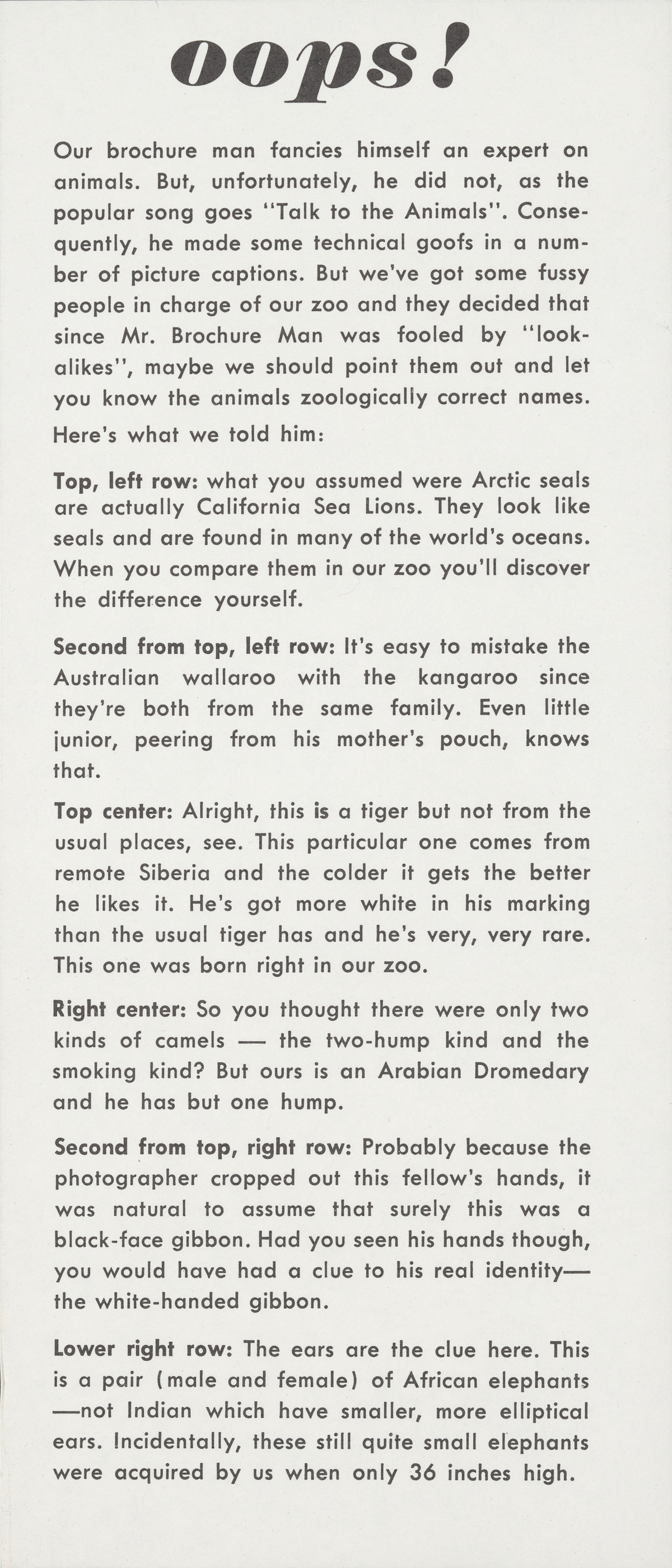Florida Memory is administered by the Florida Department of State, Division of Library and Information Services, Bureau of Archives and Records Management. The digitized records on Florida Memory come from the collections of the State Archives of Florida and the special collections of the State Library of Florida.

State Archives of Florida
- ArchivesFlorida.com
- State Archives Online Catalog
- ArchivesFlorida.com
- ArchivesFlorida.com
State Library of Florida
Related Sites

Description of previous item
Description of next item

Promotional brochure for the Jacksonville Zoological Park (Fla), circa 1967
Source
Description
Date
Format
Coverage
Topic
Subjects
Geographic Term
A walk through the Jacksonville zoo is equivalent to a safari to the game lands of all continents of the earth. Outstanding specimens of the world’s more unusual and extraordinary animals, birds, and reptiles are displayed here in enclosures that faithfully resemble each subject’s natural habitat. The absence of traditional cages and bars encourages an impression of naturalness, and improves the educational value of the menagerie collection. Come to Jacksonville zoo, and view in an afternoon a panorama of the world from the Arctic (polar bears) to far-off Peru (llamas) with stops at all continents in between.
Title
Subject
Description
Creator
Source
Date
Format
Language
Type
Identifier
Coverage
Geographic Term
Thumbnail
ImageID
topic
Subject - Corporate
Transcript
DIRECTIONS TO ZOO
GOING NORTH-—take Main St. (U.S. 17) one mile north of Trout River, turn East on Hecksher Dr. OR take I-95 North to Hecksher Dr.
GOING SOUTH-—on U.S. 17 turn east on Hecksher Dr. approx. 1 mile south of Imeson Airport OR turn off I-95 at Hecksher Dr. exit.
(see map inside)
[Photograph of a giraffe]
Jacksonville’s municipal zoo contains the largest, most varied collection of animals, birds, and reptiles in the Southeast. Children and adults alike find this exciting array from the four corners of the earth endlessly fascinating and entertaining. The zoo opens at 8 a.m. every day of the year and out-of-town visitors as well as residents are welcome.
[Photographs of a male lion and a black jaguar]
Jacksonville’s zoo has an unusually fine collection of jungle cats of which the regal African lion above and the prized black jaguar below are prime examples. The cats live in enclosures without the usual bars, separated from viewers by deep moats.
[Aerial photograph of the Jacksonville Zoo]
BIRTHDAY HOUSE MAKES A CHILD’S PARTY A HAPPY, MEMORABLE OCCASION
Here’s the answer to every parent's question “What can we do to keep them occupied?” For only 75¢ a child, a boy or girl can host a wonderful birthday party for friends in a special building furnished and decorated to appeal to children. Each child receives cake, ice cream, favors, cartoon movies and two amusement rides; and all details are handled for you by the zoo’s trained staff.
MINIMUM 10 — MAXIMUM 30 CHILDREN
PER PARTY
BY RESERVATION ONLY: CALL 765-6900
Since 1924 Jacksonville’s municipal zoo has been located on this beautiful 47-acre tree-shaded site on the north bank of Trout River. Besides a menagerie of over 800 rare animals, birds and reptiles, the zoo offers, for all citizens, recreation facilities, amusement rides, and areas for picnicking and group parties. Ample paved parking areas are provided for visitors cars.
[Upside down, across the bottom of the page]
FACILITIES FOR FAMILY PICNICS AND GROUP PARTIES ON THE GROUNDS Picnic pavilions, barbecue pits, tables and chairs are provided among the trees for families and larger groups. A family can pack a lunch and spend a carefree day viewing the animals, enjoying the amusement rides, and relaxing under the shade trees.
AMUSEMENT RIDES AND MINIATURE TRAIN INCREASE CHILDREN'S FUN
A merry-go-round, ferris wheel, and similar children's favorites are operated at modest prices on the zoo grounds. In addition, a miniature railroad train travels a mile-long track around the zoo carrying children and their parents.
A walk through the Jacksonville zoo is equivalent to a safari to the game lands of all continents of the earth. Outstanding specimens of the world’s more unusual and extraordinary animals, birds, and reptiles are displayed here in enclosures that faithfully resemble each subject’s natural habitat. The absence of traditional cages and bars encourages an impression of naturalness, and improves the educational value of the menagerie collection. Come to Jacksonville zoo, and view in an afternoon a panorama of the world from the Arctic (polar bears) to far-off Peru (llamas) with stops at all continents in between.
Our brochure man fancies himself an expert on animals. But, unfortunately, he did not, as the popular song goes ‘‘Talk to the Animals’’. Consequently, he made some technical goofs in a number of picture captions. But we’ve got some fussy people in charge of our zoo and they decided that since Mr. Brochure Man was fooled by “‘look-alikes'’, maybe we should point them out and let you know the animals zoologically correct names. Here's what we told him: Top, left row: what you assumed were Arctic seals are actually California Sea Lions. They look like seals and are found in many of the world’s oceans. When you compare them in our zoo you'll discover the difference yourself. Second from top, left row: It’s easy to mistake the Australian wallaroo with the kangaroo since they're both from the same family. Even little junior, peering from his mother’s pouch, knows that. Top center: Alright, this is a tiger but not from the usual places, see. This particular one comes from remote Siberia and the colder it gets the better he likes it. He’s got more white in his marking than the usual tiger has and he’s very, very rare. This one was born right in our zoo. Right center: So you thought there were only two kinds of camels — the two-hump kind and the smoking kind? But ours is an Arabian Dromedary and he has but one hump. Second from top, right row: Probably because the photographer cropped out this fellow’s hands, it was natural to assume that surely this was a black-face gibbon. Had you seen his hands though, you would have had a clue to his real identity — the white-handed gibbon. Lower right row: The ears are the clue here. This is a pair (male and female) of African elephants — not Indian which have smaller, more elliptical ears. Incidentally, these still quite small elephants were acquired by us when only 36 inches high.
Chicago Manual of Style
Jacksonville Zoological Park (Fla.). Promotional brochure for the Jacksonville Zoological Park (Fla), circa 1967. 1967 (circa). State Archives of Florida, Florida Memory. <https://www.floridamemory.com/items/show/351097>, accessed 4 November 2025.
MLA
Jacksonville Zoological Park (Fla.). Promotional brochure for the Jacksonville Zoological Park (Fla), circa 1967. 1967 (circa). State Archives of Florida, Florida Memory. Accessed 4 Nov. 2025.<https://www.floridamemory.com/items/show/351097>
AP Style Photo Citation
(State Archives of Florida/Jacksonville Zoological Park (Fla.))

 Listen: The Blues Program
Listen: The Blues Program
